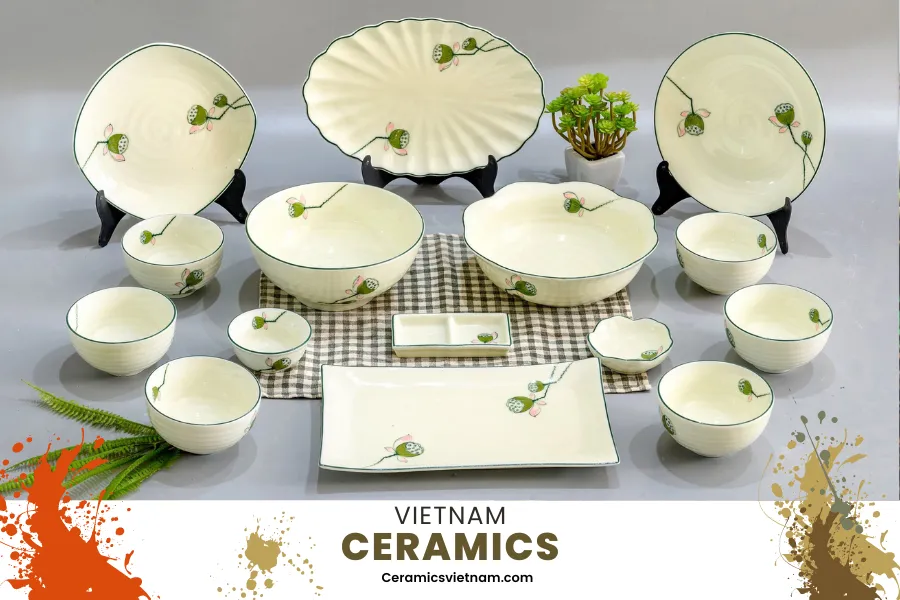Ceramic, a material deeply ingrained in our daily lives for millennia, has played a pivotal role in shaping civilizations and crafting lifestyles. Despite its ubiquity, have you ever paused to ponder the safety of this commonly used material?
Many of us possess at least one ceramic product in our households, be it tableware or tiled flooring. Generally heralded as one of the healthiest materials adorning our homes, ceramic encompasses a diverse array of items, including pottery, terracotta, earthenware, stoneware, porcelain, fine china, and bone china. Each term signifies a unique composition of materials utilized in the creation of ceramics.
In the hustle and bustle of our daily routines, we often overlook the significance of understanding the materials we surround ourselves with. It’s easy to succumb to the allure of disposable or potentially hazardous items. However, ceramic stands as a time-tested option for household use, its history dating back thousands of years. Before immersing yourself in the world of ceramics, it’s essential to acquaint yourself with these five critical facts regarding the safety of ceramic usage in your home.
Generally regarded as nonporous and non-toxic, ceramic is often celebrated as a safe material for human health. Exploring these safety considerations is imperative to make informed choices for a healthier and safer living environment.
Ceramics be made from toxic and non-toxic ingredients
Ceramics, while widely recognized for their utility and aesthetic appeal, can be crafted from a spectrum of ingredients that range from entirely non-toxic to potentially harmful substances. The safety of a particular ceramic product hinges on the conscientiousness of manufacturers when it comes to understanding and prioritizing the health and safety aspects of their materials.
Traditionally, ceramic production involved the fusion of clay and non-metal components, all subjected to high-temperature processes. This conventional method, using materials like clay, quartz, and water, was historically perceived as relatively non-toxic. However, the landscape of ceramic manufacturing has evolved over time, leading to variations in the ingredients employed by different manufacturers.
One notable shift has been the introduction of nano-materials into ceramic formulations by some manufacturers. Nano-materials consist of minuscule particles with the unique ability to penetrate the skin and traverse internal systems, including blood vessels. While certain formulations and applications of nano-materials may be deemed safe, the challenge lies in pinpointing which manufacturers embrace this innovative technology.
The introduction of nano-materials introduces a nuanced layer to the safety considerations associated with ceramics. It underscores the importance for consumers to delve into the specifics of ceramic composition, especially in an era where technology and innovation continuously reshape manufacturing practices.
As the use of nano-materials in ceramics becomes more prevalent, the scrutiny of their safety implications becomes paramount. The onus is on both manufacturers and consumers to stay abreast of these advancements, fostering an environment of transparency and awareness. This proactive approach ensures that the products we integrate into our homes align with our expectations for safety and contribute to the creation of healthier living spaces.
Ceramics are capable of heat-resistant prowess

Ceramics are capable of heat-resistant prowess
Ceramics, renowned for their heat-friendly characteristics, stand as a reliable choice in various culinary and household applications. Unlike plastics that may soften, break down, or melt under heat, ceramic products demonstrate remarkable resilience, making them suitable for use in microwaves, ovens, and on stovetops.
The versatility of ceramics in handling different heating sources adds a layer of convenience to daily activities in the kitchen. Whether you’re reheating a meal in the microwave, baking a delectable dish in the oven, or preparing a savory concoction on the stove, ceramics prove steadfast in maintaining their structural integrity.
However, the broad category of ceramics encompasses diverse materials, and not all ceramic products can universally withstand exposure to all three heating methods or appliances. This variability underscores the importance of diligently following the manufacturer’s instructions for each specific ceramic item. These guidelines outline the recommended usage scenarios, detailing which heating methods are appropriate and which should be avoided.
Moreover, understanding the intricacies of ceramic composition becomes crucial in optimizing their performance and ensuring longevity. Certain types of ceramics may excel in specific heat applications, and knowledge of these nuances enhances the user experience.
In summary, while ceramics boast an inherent heat-friendly nature, a nuanced approach to their usage is essential. Adhering to manufacturer guidelines, understanding the specifics of each ceramic item, and practicing responsible use not only preserve the longevity of these products but also contribute to a safe and enjoyable culinary and household environment.
Ceramic does not contribute to the polluting of VOCs into your home
Ceramics stand out as an environmentally conscious choice, particularly in their role of preventing the introduction of Volatile Organic Compounds (VOCs) into your home, thereby positively impacting indoor air quality.
VOCs are a group of organic chemicals known for their high vapor pressure at standard room temperatures. These compounds pose serious health risks, ranging from irritation of the eyes, nose, and throat to more severe issues like nausea, frequent headaches, and potential damage to crucial organs such as the liver, kidneys, and central nervous system. Common household items like paints, aerosol sprays, cleansers, and disinfectants often harbor VOCs, contributing to indoor air pollution.
The noteworthy aspect is that ceramics, as a material, typically do not involve the use of chemicals associated with the VOC family in their production. This means that incorporating ceramic items into your home does not contribute to the emission of VOCs, presenting a cleaner and healthier indoor environment.
The U.S. Environmental Protection Agency underscores the importance of eliminating sources of indoor air pollutants to enhance overall air quality. Choosing ceramic household products, such as the meticulously crafted ceramic tablewares by Kopin Tableware, emerges as a proactive strategy to reduce indoor VOC levels. By making this conscious choice, you not only invest in elegant and functional tableware but also contribute to a healthier living space by mitigating potential risks associated with indoor air pollution.
Ceramic tableware does not leach chemicals into your food

Ceramic tablewares does not leach chemicals into your food
Ceramic tableware provides a trustworthy and health-conscious option by ensuring that no chemicals leach into your food. This is attributed to the material’s hard surface, which acts as a barrier, making it impermeable to air, water, and other fluids.
Unlike some plastics that might allow chemicals to leach into food over time, ceramics exhibit an inherent resistance to leaching and absorption. The non-porous nature of ceramics ensures that your food remains unaffected by external substances, preserving its original taste and quality.
This quality makes ceramic tableware a particularly suitable choice for those who prioritize the safety and purity of their meals. The assurance that no harmful substances are introduced into the food enhances the overall dining experience and aligns with a health-conscious lifestyle. So, whether you’re enjoying a casual family meal or hosting a special gathering, opting for ceramic tableware adds an extra layer of confidence to your culinary endeavors.
Ceramic does not contain plastic or vinyl
Ceramic distinguishes itself by its complete absence of plastic or vinyl components, a crucial consideration given the well-documented adverse effects associated with these materials on health and indoor environments.
Plastic and vinyl, commonly found in various household and building products like food storage containers and flooring, have been linked to concerns surrounding indoor air quality and dust. These materials can release volatile compounds that contribute to air pollution indoors and, over time, may lead to the accumulation of dust particles.
By opting for ceramic, a material free from plastic and vinyl, you actively mitigate potential risks associated with these substances. This conscious choice not only safeguards your immediate environment but also aligns with a broader commitment to fostering healthier indoor spaces. As consumers become increasingly aware of the implications of material choices, the decision to embrace ceramics becomes not just an aesthetic preference but a strategic move towards a healthier and more sustainable living environment.
In summary, the intrinsic qualities of ceramics make them a versatile and safe choice for various applications within our homes. From their historical significance in shaping civilizations to their modern-day benefits, ceramics have proven to be more than just decorative elements.
Read more














Leave a reply